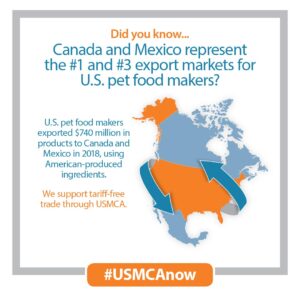 May is World Trade Month, which prompts the question: Why is global trade an important issue for U.S. pet food makers? PFI’s Peter Tabor, vice president of regulatory and international affairs, discusses the impact of global market access and why trade matters.
May is World Trade Month, which prompts the question: Why is global trade an important issue for U.S. pet food makers? PFI’s Peter Tabor, vice president of regulatory and international affairs, discusses the impact of global market access and why trade matters.
As the voice for U.S. pet food makers, one of our association’s missions is to advocate for exports and foreign market access for U.S. pet food. Members of the Pet Food Institute (PFI), who account for 98% of U.S. dog and cat food production, are important contributors to our national economy, using agricultural commodities and employing more than 30,000 workers across the country. This also supports hundreds of thousands of spin-off jobs in transportation, packaging, food services and more[1]. Sales of pet food and treats in the United States reached more than $30 billion in 2018, with nearly two-thirds of American households having at least one dog or cat[2] – that’s a lot of bowls to fill. However, the U.S. market is relatively mature and pet ownership rates remain steady. For that reason, exports represent an important and growing segment for U.S. pet food makers. While exports currently represent 5% of domestic pet food sales, that figure is sure to rise in the coming years.
North America: Pet Food Needs USMCA Now
 Established markets in Canada and Mexico continue to show great promise. Our North American neighbors represent our first and third largest export markets, respectively, and accounted for half of all U.S. exports last year, totaling $740 million dollars[3]. PFI expects this trend to continue and, for that reason and others, we are actively engaged in a coordinated effort to urge ratification of the United States-Mexico-Canada Agreement (USCMA). The USMCA will allow continued tariff-free trade with our partners to the north and south, providing both market certainty and increased opportunities for U.S. pet food makers.
Established markets in Canada and Mexico continue to show great promise. Our North American neighbors represent our first and third largest export markets, respectively, and accounted for half of all U.S. exports last year, totaling $740 million dollars[3]. PFI expects this trend to continue and, for that reason and others, we are actively engaged in a coordinated effort to urge ratification of the United States-Mexico-Canada Agreement (USCMA). The USMCA will allow continued tariff-free trade with our partners to the north and south, providing both market certainty and increased opportunities for U.S. pet food makers.
Asian Markets: Areas for Growth
Asia will figure prominently in U.S. pet food makers’ export strategy in the coming years. Similar to what we’ve seen in other countries and regions, Asian consumers are more urban, have more disposable income and increasingly view pets as family members. U.S. pet food is recognized around the world as safe and this well-deserved reputation means U.S. pet food makers have a loyal and growing customer base among Asian pet owners. Our exports to Taiwan and Korea, currently our sixth and seventh largest export markets, have risen steadily in recent years, thanks in part to the efforts of the U.S. Department of Agriculture. PFI appreciates USDA’s work on behalf of U.S. pet food makers to open and expand foreign market access, which is translating into greater opportunities.
China: Untapped Potential
Finally, U.S. access (or lack thereof) to the Chinese pet food market requires explanation. Chinese pet owners want U.S. pet food, and U.S. pet food makers are keen to enter the massive Chinese market. PFI’s market analysis conservatively estimates that unrestricted Chinese market access for American pet food could easily mean a 20% or greater jump in our total exports. Unfortunately, the Chinese government has maintained unscientific and arbitrary restrictions that have severely limited Chinese pet owners’ access to U.S. pet food. PFI supports the efforts of U.S. negotiators to ensure China ends practices that have disadvantaged many industries seeking to compete in the Chinese marketplace.
Trade in Safe Pet Food Benefits Pets and Our Economy
Increased pet food exports benefits hundreds of thousands of American workers, including the farmers and ranchers, truckers, equipment manufacturers and many more help put food in our pets’ bowls. PFI is proud to join our partners in American food and agriculture in making products that are recognized and preferred globally for their safety and quality.
[1] American Feed Industry Association
[2] American Pet Products Association